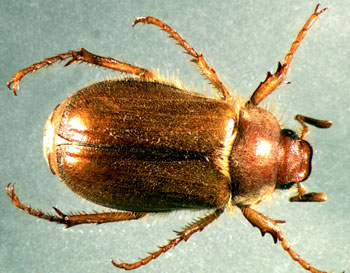Will your lawn be attacked by grubs this year?
Smart gardeners check for beetles now to predict whether grubs are a problem.
 While pulling weeds bigger than my flowers, an insect thumped me harmlessly in the head. This accidental encounter made me look up to see a large number of insects flying around the tops of the trees. These insects are European chafers, a type of beetle better known for its grub stage. It is not unusual to see this insect flying around trees and houses near dusk in late June to early July. They are the adult stage of the grub insect that can damage lawns later in the summer.
While pulling weeds bigger than my flowers, an insect thumped me harmlessly in the head. This accidental encounter made me look up to see a large number of insects flying around the tops of the trees. These insects are European chafers, a type of beetle better known for its grub stage. It is not unusual to see this insect flying around trees and houses near dusk in late June to early July. They are the adult stage of the grub insect that can damage lawns later in the summer.
If you have had problems with grubs in the past, then this is the time in Michigan’s Lower Peninsula to go out at dusk to check for these beetles. When people call the Michigan State University Extension Garden Hotline (888-678-3464) asking what to use to treat grubs, we ask them to first determine if they have a grub problem. Checking for this pest this time of year is easy. The European chafer as an adult beetle does not feed on grass or other plants, so you do not see damage on leaves, but the beetles are easy to see at dusk flying around trees at the end of June to early July. At this stage, the chafers are mating and laying eggs into the turf. If you observe just a few beetles over the course of a couple nights, then there is little need to apply pesticides. Hundreds of beetles may require some management strategies.
One step that can greatly reduce grub damage later in the summer is to raise the height of the mower now up to at least 3 inches. The highest setting on the lawn mower is usually 3.25 to 4 inches. MSU entomologist Dave Smitley states, “Trying to mow your lawn at a height less than 3 inches is actually stressful to your lawn and may result in the need to apply more insecticide and herbicide.” The higher length of grass allows the plant to produce more carbohydrates, helping to build a bigger root mass. The larger root mass improves the ability of the turf to withstand damage from grub infestations and helps crowd out weeds like crabgrass.
Adequate soil moisture also helps with root development, reducing the impact from grubs. Michigan lawns benefitted from good rainfall since the first of June, with many areas receiving 4 to 6 inches. If the weather patterns change and conditions become very dry, watering your lawn will help reduce the impact from grubs feeding on grass roots in late summer.
If you do find you have large numbers of European chafers laying eggs into your lawn, you may need to treat for grubs. Correct timing of applications helps to reduce over use of pesticides. The MSU Turfgrass Science website explains the correct use and timing of pesticides for grub control.
Be a smart gardener and take steps now to determine if you even need pesticides for grubs. Watch for European chafers in the evenings, maintain high mowing heights and monitor the lawn’s need for water.
Also see:



 Print
Print Email
Email